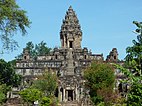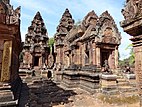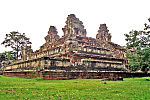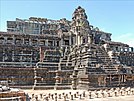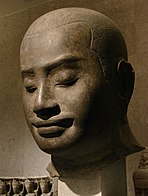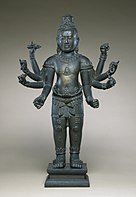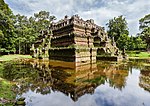Khmer Empire
Khmer Empire ចក្រភពខ្មែរ | |||||||||||
|---|---|---|---|---|---|---|---|---|---|---|---|
| 802–1431 | |||||||||||
 | |||||||||||
 The Khmer Empire at its height of territorial expansion in 1203 CE after the conquest of Champa. | |||||||||||
| Capital | Mahendraparvata (early 9th cent.) Hariharalaya (9th cent.) Koh Ker (928–944) Yasodharapura (Angkor) (late 9th to early 15th cent.) | ||||||||||
| Common languages | Old Khmer Sanskrit | ||||||||||
| Religion | Hinduism Mahayana Buddhism Theravada Buddhism | ||||||||||
| Government | Divine, absolute monarchy | ||||||||||
| King | |||||||||||
• 802–850 | Jayavarman II | ||||||||||
• 1113–1150 | Suryavarman II | ||||||||||
• 1181–1218 | Jayavarman VII | ||||||||||
• 1417–1431 | Ponhea Yat | ||||||||||
| Historical era | Middle Ages | ||||||||||
• Enthronement of Jayavarman II | 802 | ||||||||||
• Construction of Angkor Wat | 1113–1150 | ||||||||||
| 1431 | |||||||||||
| Area | |||||||||||
| 1290[1][2] | 1,000,000 km2 (390,000 sq mi) | ||||||||||
| Population | |||||||||||
• 1150 | 2,000,000 | ||||||||||
| |||||||||||
| History of Cambodia |
|---|
| Early history |
|
| Post-Angkor Period |
|
| Colonial period |
|
| Independence and conflict |
|
| Peace process |
|
| Modern Cambodia |
|
| By topic |
|
|
|
The Khmer Empire (Khmer: ចក្រភពខ្មែរ), or the Angkorian Empire (Khmer: ចក្រភពអង្គរ), are the terms that historians use to refer to Cambodia from the 9th century to the 15th century when the nation was a Hindu/Buddhist empire in Southeast Asia. The empire grew out of the former civilizations of Funan and Chenla, at times ruled over and/or vassalised most of mainland Southeast Asia[3] and parts of Southern China, stretching from the tip of the Indochinese Peninsula northward to modern Yunnan province, China, and from Vietnam westward to Myanmar.[4][5]
Perhaps its most notable legacy is the site of Angkor, in present-day Cambodia, the Khmer capital during the empire's zenith. The majestic monuments of Angkor, such as Angkor Wat and Bayon, bear testimony to the Khmer Empire's immense power and wealth, impressive art and culture, architectural technique, aesthetics achievements, and the variety of belief systems that it patronised over time. Satellite imaging has revealed that Angkor, during its peak in the 11th to 13th centuries, was the largest pre-industrial urban centre in the world.[6]
The beginning of the era of the Khmer Empire is conventionally dated to 802 when King Jayavarman II declared himself chakravartin ("universal ruler", title equivalent to "emperor") on Phnom Kulen. The empire ended with the Siege of Angkor in the 15th century.
Etymology[]
Modern scholars often refer to the empire as the Khmer Empire, or the Angkorian Empire, the latter of which has its named derive from the former capital city of Angkor.
The empire referred to itself as Kambuja (Sanskrit: कम्बोज; Old Khmer: កម្វុជ; Khmer: កម្ពុជ) or Kambujadeśa (Sanskrit: कम्बुजदेश; Old Khmer: កម្វុជទេឝ; Khmer: កម្ពុជទេស) which were ancient terms for Cambodia.
Historiography[]
The history of Angkor as the central area of settlement of the historical kingdom of Kambujadesa is also the history of the Khmer kingdom from the 9th to the 13th centuries.[7]
From Kambuja itself—and so also from the Angkor region—no written records have survived other than stone inscriptions. Therefore, the current knowledge of the historical Khmer civilisation is derived primarily from:
- Archaeological excavation, reconstruction and investigation
- Stone inscriptions (the most important of which are foundation steles of temples), which report on the political and religious deeds of the kings
- Reliefs in a series of temple walls with depictions of military marches, life in the palace, market scenes, and the daily life of the population
- Reports and chronicles of Chinese diplomats, traders and travellers.
History[]
Formation and growth[]
Jayavarman II – the founder of Angkor[]
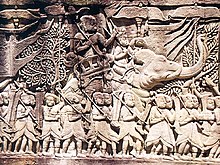
According to Sdok Kok Thom inscription,[8]: 97 [9]: 353–354 circa 781 Indrapura was the first capital of Jayavarman II, located in Banteay Prei Nokor, near today's Kompong Cham.[10] After he eventually returned to his home, the former kingdom of Chenla, he quickly built up his influence, conquered a series of competing kings, and in 790 became king of a kingdom called Kambuja by the Khmer. He then moved his court northwest to Mahendraparvata, far inland north from the great lake of Tonle Sap.
Jayavarman II (802–835)[11]: xiii, 59 is widely regarded as a king who set the foundations of the Angkor period in Cambodian history, beginning with a grandiose consecration ritual that he conducted in 802 on the sacred Mount Mahendraparvata, now known as Phnom Kulen, to celebrate the independence of Kambuja from a place inscriptions call "Java"[12] At that ceremony Prince Jayavarman II was proclaimed a universal monarch (Cambodian: Kamraten jagad ta Raja) or God King (Sanskrit: Deva Raja).[13]: 35 or "The Lords of Mountains", hence the concept of Deva Raja or God King was ostensibly imported from Java.[8]: 99–101
He declared himself Chakravartin in a ritual taken from the Hindu tradition, thereby not only becoming the divinely appointed and therefore uncontested ruler, but also simultaneously declaring the independence of his kingdom from Java. According to some sources, Jayavarman II had resided for some time in Java during the reign of Sailendras,[13]: 35 or "The Lords of Mountains", hence the concept of Deva Raja or God King was ostensibly imported from Java.[8]: 99–101 At that time, Sailendras allegedly ruled over Java, Sumatra, the Malay Peninsula and parts of Cambodia,[14] around the Mekong delta.
The first pieces of information on Jayavarman II came from the K.235 stone inscription on a stele in Sdok Kok Thom temple, Isan region, dating to 1053. It recounts two and a half centuries of service that members of the temple's founding family provided for the Khmer court, mainly as chief chaplains of the Shaivite Hindu religion.[15]
Historians debate whether "Java" means the Indonesian island of Java, Champa or a different location. According to an older established interpretation, Jayavarman II was a prince who lived at the court of Sailendra in Java and brought back to his home the art and culture of the Javanese Sailendran court to Cambodia.[8]: 97 This classical theory was revisited by modern scholars such as Claude Jacques[16] and Michael Vickery, who noted that Khmer used the term chvea to describe the Chams, their close neighbours.[17] Moreover, Jayavarman's political career began at Vyadhapura (probably Banteay Prei Nokor) in eastern Cambodia, which makes the scenario of longtime contacts with the Chams (even through skirmishes, as the inscription suggests) more probable than the scenario of a long stay in distant Java.[18] Finally, many early temples on Phnom Kulen show both Cham (e.g. Prasat Damrei Krap) and Javanese influences (e.g. the primitive "temple-mountain" of Aram Rong Cen and Prasat Thmar Dap), even if their asymmetric distribution seems typically Khmer.[19]
In the following years, he extended his territory and, later in his reign, moved from Mahendraparvata and established his new capital of Hariharalaya near the modern Cambodian town of Rolous.[8]: 98 He thereby laid the foundation of Angkor, which was to arise some 15 km to the northwest. Jayavarman II died in the year 835[11]: 59 and he was succeeded by his son Jayavarman III.[8]: 103 [20] Jayavarman III died in 877 and was succeeded by Indravarman I.[8]: 110
The successors of Jayavarman II continually extended the territory of Kambuja. Indravarman I (reigned 877–889) managed to expand the kingdom without wars and initiated extensive building projects, which were enabled by the wealth gained through trade and agriculture. Foremost were the temple of Preah Ko and irrigation works. Indravarman I developed Hariharalaya further by constructing Bakong[9]: 354–358 circa 881.[8]: 110–111 Bakong in particular bears striking similarity to the Borobudur temple in Java, which strongly suggests that it served as the prototype for Bakong. There must have been exchanges of travelers, if not missions, between the Khmer kingdom and the Sailendras in Java, transmitting to Cambodia not only ideas, but also technical and architectural details.[21]
Yasodharapura – the first city of Angkor[]
Indravarman I was followed by his son Yasovarman I (reigned 889 – 915), who established a new capital, Yasodharapura – the first city of Angkor. The city's central temple was built on Phnom Bakheng, a hill which rises around 60 m above the plain on which Angkor sits. Under Yasovarman I the East Baray was also created, a massive water reservoir of 7.1 by 1.7 km.[8]: 111–114 [9]: 358, 360–361
At the beginning of the 10th century, the kingdom split. Jayavarman IV established a new capital at Koh Ker, some 100 km northeast of Angkor, called Lingapura.[9]: 360, 363 Only with Rajendravarman II (reigned 944–968) was the royal palace returned to Yasodharapura. He took up again the extensive building schemes of the earlier kings and established a series of temples in the Angkor area, not the least being the East Mebon, a temple located on an artificial island in the center of the East Baray, and several Buddhist temples, such as Pre Rup, and monasteries.[9]: 363–367 In 950, the first war took place between Kambuja and the kingdom of Champa to the east (in the modern central Vietnam).[8]: 114–117
The son of Rajendravarman II, Jayavarman V, reigned from 968 to 1001. After he had established himself as the new king over the other princes, his rule was a largely peaceful period, marked by prosperity and a cultural flowering. He established a new capital slightly west of his father's and named it Jayendranagari; its state temple, Ta Keo, was to the south. At the court of Jayavarman V lived philosophers, scholars, and artists. New temples were also established: the most important of these are Banteay Srei, considered one of the most beautiful and artistic of Angkor, and Ta Keo, the first temple of Angkor built completely of sandstone.[8]: 117–118 [9]: 367
A decade of conflict followed the death of Jayavarman V. Three kings reigned simultaneously as antagonists until Suryavarman I (reigned 1006 – 1050) gained the throne.[8]: 134–135 Suryavarman I established diplomatic relations with the Chola dynasty of south India.[22] Suryavarman I sent a chariot as a present to the Chola Emperor Rajaraja Chola I.[23] His rule was marked by repeated attempts by his opponents to overthrow him and by military conquests. Suryavarman was successful in taking control of the Khmer capital city of Angkor Wat.[24]
At the same time, Angkor Wat came into conflict with the Tambralinga kingdom of the Malay peninsula.[24][25] In other words, there was a three-way conflict in mainland Southeast Asia. After surviving several invasions from his enemies, Suryavarman requested aid from the powerful Chola Emperor Rajendra Chola I of the Chola dynasty against the Tambralinga kingdom.[24][26][27] After learning of Suryavarman's alliance with Rajendra Chola, the Tambralinga kingdom requested aid from the Srivijaya King Sangrama Vijayatungavarman.[24][25]
This eventually led to the Chola Empire coming into conflict with the Srivijaya Empire. The war ended with a victory for the Chola dynasty and of the Khmer Empire, and major losses for the Srivijaya Empire and the Tambralinga kingdom.[24][25] This alliance also had religious nuance, since both Chola and Khmer empire were Hindu Shaivite, while Tambralinga and Srivijaya were Mahayana Buddhist. There is some indication that before or after these incidents Suryavarman I sent a gift, a chariot, to Rajendra Chola I to possibly facilitate trade or an alliance.[8]: 136 [28] Suryavarman I's wife was Viralakshmi, and following his death in 1050, he was succeeded by Udayadityavarman II, who built the Baphuon and West Baray.[8]: 135, 137–138 In 1074, conflict arose between Harshavarman III and the Champa King Harivarman IV.[8]: 152
Golden age of Khmer Civilization[]
Suryavarman II – Angkor Wat[]
The 12th century was a time of conflict and brutal power struggles. Under Suryavarman II (reigned 1113–1150) the kingdom united internally[11]: 113 and the large temple of Angkor was built in a period of 37 years: Angkor Wat, dedicated to the god Vishnu.
In the east, his campaigns against Champa, and Dai Viet, were unsuccessful,[11]: 114 though he sacked Vijaya in 1145 and deposed Jaya Indravarman III.[29]: 75–76 The Khmers occupied Vijaya until 1149, when they were driven out by Jaya Harivarman I.[8]: 160 Suryavarman II sent a mission to the Chola dynasty of south India and presented a precious stone to the Chola emperor Kulottunga Chola I in 1114.[30][31]
Another period followed in which kings reigned briefly and were violently overthrown by their successors. Finally, in 1177 the capital was raided and looted in a naval battle on the Tonlé Sap lake by a Cham fleet under Jaya Indravarman IV, and Tribhuvanadityavarman was killed.[8]: 164 [29]: 78
Jayavarman VII – Angkor Thom[]
King Jayavarman VII (reigned 1181–1219) was generally considered Cambodia's greatest king. He had already been a military leader as a prince under the previous kings. After the Cham had conquered Angkor, he gathered an army and regained the capital. He ascended the throne and continued the war against the neighbouring eastern kingdom for another 22 years, until the Khmer defeated Champa in 1203 and conquered large parts of its territory.[8]: 170–171 [29]: 79–80 According to Chinese sources, Jayavarman VII added Pegu to the territory of the Khmer Empire in 1195.[32]
Jayavarman VII stands as the last of the great kings of Angkor, not only because of his successful war against the Cham, but also because he was not a tyrannical ruler in the manner of his immediate predecessors. He unified the empire and carried out noteworthy building projects. The new capital, now called Angkor Thom (literally: "Great City"), was built. In the centre, the king (himself a follower of Mahayana Buddhism) had constructed as the state temple the Bayon,[9]: 378–382 with towers bearing faces of the boddhisattva Avalokiteshvara, each several metres high, carved out of stone. Further important temples built under Jayavarman VII were Ta Prohm for his mother, Preah Khan for his father,[9]: 388–389 Banteay Kdei, and Neak Pean, as well as the reservoir of Srah Srang. An extensive network of roads was laid down connecting every town of the empire, with rest-houses built for travelers and a total of 102 hospitals established across his realm.[8]: 173, 176
Jayavarman VIII – the last blooming[]
After the death of Jayavarman VII, his son Indravarman II (reigned 1219–1243) ascended the throne.[8]: 180–181 Like his father, he was a Buddhist, and he completed a series of temples begun under his father's rule. As a warrior he was less successful. In the year 1220, under mounting pressure from increasingly powerful Đại Việt, and its Cham alliance, the Khmer withdrew from many of the provinces previously conquered from Champa. In the west, his Thai subjects rebelled, establishing the first Thai kingdom at Sukhothai and pushing back the Khmer. In the following 200 years, the Thais would become the chief rivals of Kambuja.
Indravarman II was succeeded by Jayavarman VIII (reigned 1243–1295). In contrast to his predecessors, Jayavarman VIII was a follower of Hindu Shaivism and an aggressive opponent of Buddhism, destroying many Buddha statues in the empire and converting Buddhist temples to Hindu temples.[11]: 133 From the outside, the empire was threatened in 1283 by the Mongols under Kublai Khan's general (sometimes known as Sagatu or Sodu), who was the governor of Guangzhou, China.[33] The king avoided war with his powerful opponent, who ruled all of China, by paying annual tribute, starting in 1285.[8]: 192 [33] Jayavarman VIII's rule ended in 1295 when he was deposed by his son-in-law Srindravarman (reigned 1295–1309). The new king was a follower of Theravada Buddhism, a school of Buddhism that had arrived in southeast Asia from Sri Lanka and subsequently spread through most of the region.
In August 1296, the Chinese diplomat Zhou Daguan arrived at Angkor and recorded, "In the recent war with the Siamese, the country was utterly devastated."[8]: 211 [29]: 90 He remained at the court of King Srindravarman until July 1297. He was neither the first nor the last Chinese representative to visit Kambuja. His stay is notable, however, because Zhou Daguan later wrote a detailed report on life in Angkor. His portrayal is today one of the most important sources of understanding historical Angkor. Alongside descriptions of several great temples (the Bayon, the Baphuon, Angkor Wat) – his account informs us that the towers of the Bayon were once covered in gold – the text also offers valuable information on the everyday life and the habits of the inhabitants of Angkor.
Decline[]
By the 14th century, the Khmer empire suffered a long, arduous, and steady decline. Historians have proposed different causes for the decline: the religious conversion from Vishnuite-Shivaite Hinduism to Theravada Buddhism that affected social and political systems, incessant internal power struggles among Khmer princes, vassal revolt, foreign invasion, plague, and ecological breakdown.
For social and religious reasons, many aspects contributed to the decline of the Khmer empire. The relationship between the rulers and their elites was unstable – among the 27 Angkorian rulers, eleven lacked a legitimate claim to power, and civil wars were frequent. The Khmer empire focused more on the domestic economy and did not take advantage of the international maritime network. In addition, the input of Buddhist ideas conflicted and disturbed the state order built under the predominant Hinduism.[34]
Conversion of faith[]
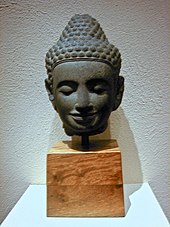
The last Sanskrit inscription is dated 1327 and describes the succession of Indrajayavarman by Jayavarmadiparamesvara.[8]: 228 Historians suspect a connection with the kings' adoption of Theravada Buddhism: they were therefore no longer considered "devarajas", and there was no need to erect huge temples to them, or rather to the gods under whose protection they stood. The retreat from the concept of the devaraja may also have led to a loss of royal authority and thereby to a lack of workers. The water-management apparatus also degenerated, meaning that harvests were reduced by floods or drought. While previously three rice harvests per year were possible – a substantial contribution to the prosperity and power of Kambuja – the declining harvests further weakened the empire.
Looking at the archaeological record, however, archaeologists noticed that not only were the structures ceasing to be built, but the Khmer's historical inscription was also lacking from the period of 1300–1600. With this lack of historical content, there is unfortunately very limited archaeological evidence to work with. Archaeologists have been able to determine that the sites were abandoned and then reoccupied later by different people.[35]
Foreign pressure[]
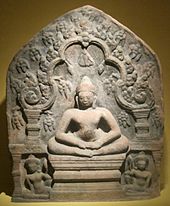
The western neighbour of the Khmer, the first Thai kingdom of Sukhothai, after repelling Angkorian hegemony, was conquered by another stronger Thai kingdom in the lower Chao Phraya Basin, Ayutthaya, in 1350. From the fourteenth century on, Ayutthaya became Angkor's rival.[8]: 222–223 Angkor was besieged by the Ayutthayan king Uthong in 1352, and following its capture the next year, the Khmer monarch was replaced with successive Siamese princes. Then in 1357, the Khmer king regained the throne.[8]: 236 In 1393, the Ayutthayan king Ramesuan besieged Angkor again, capturing it the next year. Ramesuan's son ruled Khmer a short time before being assassinated. Finally, in 1431, the Khmer king Ponhea Yat abandoned Angkor as indefensible, and moved to the Phnom Penh area.[8]: 236–237
The new centre of the Khmer kingdom was in the southwest, at Oudong in the region of today's Phnom Penh. However, there are indications that Angkor was not completely abandoned. One line of Khmer kings may have remained there, while a second moved to Phnom Penh to establish a parallel kingdom. The final fall of Angkor would then be due to the transfer of economic – and therewith political – significance, as Phnom Penh became an important trade centre on the Mekong. Besides, severe droughts and ensuing floods were considered one of the contributing factors to its fall.[36] The empire focused more on regional trade after the first drought.[37]
Ecological breakdown[]
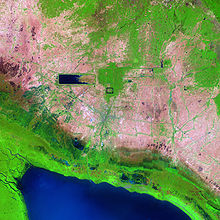
Ecological failure and infrastructural breakdown is a new alternative theory regarding the end of the Khmer Empire. Scientists working on the Greater Angkor Project believe that the Khmers had an elaborate system of reservoirs and canals used for trade, transportation, and irrigation. The canals were used for harvesting rice. As the population grew there was more strain on the water system. During the fourteenth and fifteenth centuries, there were also severe climatic changes impacting the water management system.[36]
Periods of drought led to decreases in agricultural productivity, and violent floods due to monsoons damaged the infrastructure during this vulnerable time.[36] To adapt to the growing population, trees were cut down from the Kulen hills and cleared out for more rice fields. That created rain runoff carrying sediment to the canal network. Any damage to the water system would have enormous consequences.[38]
Plague[]
The plague theory, which suggests a severe epidemic outbreak might have hit the heavily populated Angkor and contributed to the fall of the empire, has been reconsidered.[39] By the 14th century, the Black Death had affected Asia, as the plague first appeared in China around 1330 and reached Europe around 1345. Most seaports along the line of travel from China to Europe felt the impact of the disease, which might have had a severe impact on life throughout Southeast Asia. Possible diseases include bubonic plague, smallpox and malaria.
Angkor after the 15th century[]
In any event, there is evidence for a further period of use of Angkor. Under the rule of King Barom Reachea I (reigned 1566–1576), who temporarily succeeded in driving back the Thai, the royal court was briefly returned to Angkor. Inscriptions from the 17th century testify to Japanese settlements alongside those of the remaining Khmer.[40] The best-known inscription tells of Ukondayu Kazufusa, who celebrated the Khmer New Year there in 1632.[41] However, in following decades the Japanese community was absorbed into the local Khmer community, owing to the lack of new Japanese arrivals and very little possibility of renewing their community.[40]
Culture and society[]

Much of what is known of the ancient Khmer society comes from the many bas-reliefs and also the first-hand Chinese accounts of Zhou Daguan, which provide information on 13th-century Cambodia and earlier. The bas-reliefs of Angkor temples, such as those in Bayon, describe everyday life of the ancient Khmer kingdom, including scenes of palace life, naval battles on the river or lakes, and common scenes of the marketplace.
Economy and agriculture[]
The ancient Khmers were a traditional agricultural community, relying heavily on rice farming. The farmers, who formed the majority of kingdom's population, planted rice near the banks of the lake or river, in the irrigated plains surrounding their villages, or in the hills when lowlands were flooded. The rice paddies were irrigated by a massive and complex hydraulics system, including networks of canals and barays, or giant water reservoirs. This system enabled the formation of large-scale rice farming communities surrounding Khmer cities. Sugar palm trees, fruit trees, and vegetables were grown in the orchards by the villages, providing other sources of agricultural produce such as palm sugar, palm wine, coconut, various tropical fruits, and vegetables.
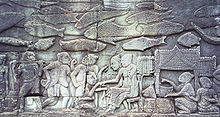
Located by the massive Tonlé Sap lake, and also near numerous rivers and ponds, many Khmer people relied on fresh water fisheries for their living. Fishing gave the population their main source of protein, which was turned into prahok — dried or roasted or steamed fish paste wrapped in banana leaves. Rice was the main staple along with fish. Other sources of protein included pigs, cattle, and poultry, which were kept under the farmers' houses, which were on stilts to protect them from flooding.
The marketplace of Angkor contained no permanent buildings; it was an open square where the traders sat on the ground on woven straw mats and sold their wares. There were no tables or chairs. Some traders might be protected from the sun with a simple thatched parasol. A certain type of tax or rent was levied by officials for each space occupied by traders in the marketplace. The trade and economy in the Angkor marketplace were mainly run by women.
Zhou Daguan's description of the women of Angkor:[42][43]
The local people who know how to trade are all women. So when a Chinese goes to this country, the first thing he must do is take in a woman, partly with a view to profiting from her trading abilities.
The women age very quickly, no doubt because they marry and give birth when too young. When they are twenty or thirty years old, they look like Chinese women who are forty or fifty.
The role of women in the trade and economy of the Khmer Empire suggests that they enjoyed significant rights and freedom. Their practice of marrying early may have contributed to the high fertility rate and huge population of the kingdom.
Society and politics[]

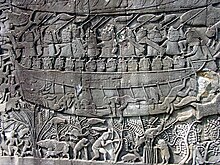
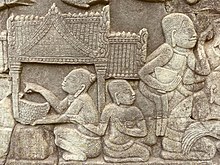
The Khmer empire was founded upon extensive networks of agricultural rice farming communities. A distinct settlement hierarchy is present in the region. Small villages were clustered around regional centres, such as the one at Phimai, which in turn sent their goods to large cities like Angkor in return for other goods, such as pottery and foreign trade items from China.[44] The king and his officials were in charge of irrigation management and water distribution, which consisted of an intricate series of hydraulics infrastructure, such as canals, moats, and massive reservoirs called barays.
Society was arranged in a hierarchy reflecting the Hindu caste system[citation needed], where the commoners – rice farmers and fishermen – formed the large majority of the population. The kshatriyas – royalty, nobles, warlords, soldiers, and warriors – formed a governing elite and authorities. Other social classes included brahmins (priests), traders, artisans such as carpenters and stonemasons, potters, metalworkers, goldsmiths, and textile weavers, while on the lowest social level were slaves.
The extensive irrigation projects provided rice surpluses that could support a large population. The state religion was Hinduism but influenced by the cult of Devaraja, elevating the Khmer kings as possessing the divine quality of living gods on earth, attributed to the incarnation of Vishnu or Shiva.[45] In politics, this status was viewed as the divine justification of a king's rule. The cult enabled the Khmer kings to embark on massive architectural projects, constructing majestic monuments such as Angkor Wat and Bayon to celebrate the king's divine rule on earth.
The King was surrounded by ministers, state officials, nobles, royalties, palace women, and servants, all protected by guards and troops. The capital city of Angkor and the Khmer royal court are famous for grand ceremonies, with many festivals and rituals held in the city. Even when travelling, the King and his entourages created quite a spectacle, as described in Zhou Daguan's account:
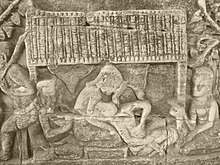
Zhou Daguan's description of a royal procession of Indravarman III:[46]
When the king goes out, troops are at the head of [his] escort; then come flags, banners and music. Palace women, numbering from three to five hundred, wearing flowered cloth, with flowers in their hair, hold candles in their hands, and form a troupe. Even in broad daylight, the candles are lighted. Then come other palace women, bearing royal paraphernalia made of gold and silver... Then come the palace women carrying lances and shields, with the king's private guards. Carts drawn by goats and horses, all in gold, come next. Ministers and princes are mounted on elephants, and in front of them one can see, from afar, their innumerable red umbrellas. After them come the wives and concubines of the king, in palanquins, carriages, on horseback and on elephants. They have more than one hundred parasols, flecked with gold. Behind them comes the sovereign, standing on an elephant, holding his sacred sword in his hand. The elephant's tusks are encased in gold.
Zhou Daguan's description of the Khmer king's wardrobe:[43]
Only the ruler can dress in cloth with an all-over floral design…Around his neck he wears about three pounds of big pearls. At his wrists, ankles and fingers he has gold bracelets and rings all set with cat's eyes…When he goes out, he holds a golden sword [of state] in his hand.
Khmer kings were often involved in series of wars and conquests. The large population of Angkor enabled the kingdom to support large free standing armies, which were sometimes deployed to conquer neighbouring princedoms or kingdoms. Series of conquests were led to expand the kingdom's influence over areas surrounding Angkor and Tonle Sap, the Mekong valley and delta, and surrounding lands. Some Khmer kings embarked on military conquests and war against neighbouring Champa, Dai Viet, and Thai warlords. Khmer kings and royal families were also often involved in incessant power struggle over successions or rivalries over principalities.
Military[]
According to the Chinese traveler Zhou Daguan, who stayed in Yaśodharapura between 1296 and 1297, the Sukhothai Kingdom laid waste to Khmer lands in repeated wars. According to Zhou, the Khmer soldiers fought naked and barefoot, wielding only lance and shield. They did not use bows and arrows, trebuchets, body armour, or helmets. When Sukhotai attacked, ordinary people were ordered to face them with no strategy or preparation.[47] The Khmer had double bow crossbows mounted on elephants, which Michel JacqHergoualc’h suggest were elements of Cham mercenaries in Jayavarman VII's army.[48]
In terms of fortifications, Zhou described Angkor Thom's walls as being 10 kilometers long in circumference with five gateways, each with two gates, surrounded by a large moat spanned by bridges. The walls, which formed an exact square, were made of stone and so tightly packed that no weeds grew from them. The walls were around 6-7 meters in height and sloped from the inside, thick enough to contain chambers, but with no battlements, and only a single stone tower on each of the four sides. They were manned by guards but dogs were not allowed on the walls.[49]
Culture and way of life[]


Zhou Daguan's description of Khmer houses:[43]
The dwellings of the princes and principal officials have a completely different layout and dimensions from those of the people. All the outlying buildings are covered with thatch; only the family temple and the principal apartment can be covered in tiles. The official rank of each person determines the size of the houses.
Houses of farmers were situated near the rice paddies on the edge of the cities. The walls of the houses were made of woven bamboo, with thatched roofs, and they were on stilts. A house was divided into three rooms by woven bamboo walls. One was the parents' bedroom, another was the daughters' bedroom, and the largest was the living area. Sons slept wherever they could find space. The kitchen was at the back or in a separate room. Nobles and kings lived in the palace and much larger houses in the city. They were made of the same materials as the farmers' houses, but the roofs were wooden shingles and had elaborate designs as well as more rooms.
The common people wore a sampot where the front end was drawn between the legs and secured at the back by a belt. Nobles and kings wore finer and richer fabrics. Women wore a strip of cloth to cover the chest, while noble women had a lengthened one that went over the shoulder. Men and women wore a Krama. Along with depictions of battle and the military conquests of kings, the basreliefs of Bayon depict the mundane everyday life of common Khmer people, including scenes of the marketplace, fishermen, butchers, people playing a chess-like game, and gambling during cockfighting.
Religion[]
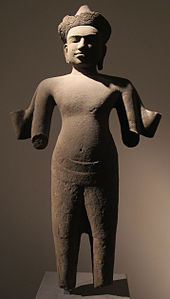
The main religion was Hinduism, followed by Buddhism in popularity. Initially, the kingdom revered Hinduism as the main state religion. Vishnu and Shiva were the most revered deities, worshipped in Khmer Hindu temples. Temples such as Angkor Wat are actually known as Phitsanulok (Vara Vishnuloka in Sanskrit) or the realm of Vishnu, to honor the posthumous King Suryavarman II as Vishnu.
Hindu ceremonies and rituals performed by Brahmins (Hindu priests), usually only held among the ruling elites of the king's family, nobles, and the ruling class. The empire's official religions included Hinduism and Mahayana Buddhism until Theravada Buddhism prevailed, even among the lower classes, after its introduction from Sri Lanka in the 13th century.[50]
Art and architecture[]
Zhou Daguan's description on the Angkor Royal Palace:[51]
All official buildings and homes of the aristocracy, including the Royal Palace, face the east. The Royal Palace stands north of the Golden Tower and the Bridge of Gold: it is one and a half mile in circumference. The tiles of the main dwelling are of lead. Other dwellings are covered with yellow-coloured pottery tiles. Carved or painted Buddhas decorate all the immense columns and lintels. The roofs are impressive too. Open corridors and long colonnades, arranged in harmonious patterns, stretch away on all sides.
| Wikimedia Commons has media related to Khmer architecture. |
The Khmer empire produced numerous temples and majestic monuments to celebrate the divine authority of Khmer kings. Khmer architecture reflects the Hindu belief that the temple was built to recreate the abode of Hindu gods, Mount Meru, with its five peaks and surrounded by seas represented by ponds and moats. The early Khmer temples built in the Angkor region and the Bakong temple in Hariharalaya (Roluos) employed stepped pyramid structures to represent the sacred temple-mountain.
Khmer art and architecture reached their aesthetic and technical peak with the construction of the majestic temple Angkor Wat. Other temples are also constructed in the Angkor region, such as Ta Phrom and Bayon. The construction of the temple demonstrates the artistic and technical achievements of the Khmer Empire through its architectural mastery of stone masonry.
List of architectural styles during Angkor period:[52]
| Styles | Dates | Rulers | Temples | Chief Characteristics |
|---|---|---|---|---|
| Kulen | 825–875 | Jayavarman II | Continuation of pre-Angkorean but a period of innovation and borrowing such as from Cham temples. Tower mainly square and relatively high. Mainly brick with laterite walls and stone door surrounds. Square and octagonal colonettes begin to appear. | |
| Preah Ko | 877–886 | Indravarman I Jayavarman III | Preah Ko, Bakong, Lolei | Simple plan: one or more square brick towers on a single base. First appearance of concentric enclosures and of gopura and libraries. Decorative 'flying palaces' replaced by dvarapalas and devatas in niches. First major temple mountain at Bakong. |
| Bakheng | 889–923 | Yasovarman I Harshavarman I | Phnom Bakheng, Phnom Krom, Phnom Bok, Baksei Chamkrong (trans.) | Development of the temple mountain. More use of stone, particularly for major temples and more decorative stone carving. |
| Koh Ker | 921–944 | Jayavarman IV | Group of Koh Ker temples | Scale of buildings diminishes toward center. Brick still main material but sandstone also used. |
| Pre Rup | 944–968 | Rajendravarman | Pre Rup, East Mebon, Bat Chum, Kutisvara | Transitional between Koh Ker and Banteay Srei. Long halls partly enclose sanctuary. The last great monuments in plastered brick, increasing use of sandstone. |
| Banteay Srei | 967–1000 | Jayavarman V | Banteay Srei | , superposed pediments, sweeping gable ends, rich and deep carving. Plasterd brick replaced by stone and laterite. Appearance of scenes in pediments. Voluptuous devatas with gentle expressions. |
| Khleang | 968–1010 | Jayavarman V | Ta Keo, The Khleangs, Phimeanakas, Royal Palace | First use of galleries. Cruciform gopuras. Octagonal colonettes. Restrained decorative carving. |
| Baphuon | 1050–1080 | Udayadityavarman II | Baphuon, West Mebon | A return to rich carving: floral motifs but also lintels with scenes. Nagas without head-dress. Bas-reliefs appear at Baphuon temple, carving with lively scenes enclosed in small panels, often in narritive sequence. |
| Angkor Wat | 1113–1175 | Suryavarman II Yasovarman II | Angkor Wat, Banteay Samré, Thommanon, Chau Say Tevoda, Beng Mealea, some of Preah Pithu, Phimai and Phnom Rung | The high classical style of Khmer architecture. Fully developed conical towers with carving profile. Galleries wider and with half galleries on one side. Concentric enclosures connected by axial galleries. Nagas with head-dress, naga balustrades raised off the ground. Invention of cross-shaped terrace. Richly carved lintels and other decorations. Bas-reliefs, Apsaras. |
| Bayon | 1181–1243 | Jayavarman VII Indravarman II | Ta Prohm, Preah Khan, Neak Pean, Ta Som, Ta Nei, Angkor Thom, Prasat Chrung, Bayon, Elephant terrace, Ta Prohm Kel, Krol Ko, Prasat Suor Prat, Banteay Chhmar, Hospital Chaples, Jayatataka baray | The last great style. Hurried construction, often in laterite not stone, carving less elegant. Complex plans, huge temples. In Cambodia, face-towers and historical narrative bas-reliefs. Three periods: 1. large complex temples on a single level, 2. face-towers and avenues of giants carrying nagas, 3. decline of the building standards, devatas acquire Angkor Wat style diadem. |
| Post Bayon | 1243–15th C. | Jayavarman VIII and others | Terrace of the Leper King, Preah Pithu, Preah Palilay (modifications to temples) | Inversion of cross-shaped terrace, causeways on columns, low or high. |
Relations with regional powers[]
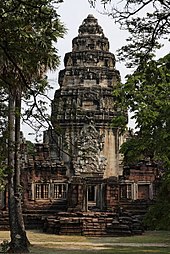
During the formation of the empire, the Khmer had close cultural, political, and trade relations with Java[14] and with the Srivijaya empire that lay beyond Khmer's southern seas. In 851 an Arabic merchant named Sulaimaan recorded an incident involving a Khmer king and a Maharaja of Zabaj. He described the story of a Khmer king who defied the power of Maharaja of Zabaj. It was said that the Javanese Sailendras staged a surprise attack on the Khmers by approaching the capital from the river. The young king was later punished by the Maharaja, and subsequently the kingdom became a vassal of the Sailendra dynasty.[13]: 35
Zabaj is the Arabic form of Javaka and might refer to Java or Srivijaya. The legend probably describes the predecessor or initial stage of the Khmer kingdom under Javanese dominion.[53] The Legend of the Maharaja of Zabaj was later published by the historian Masoudi in his 947 book, "Meadows of Gold and Mines of Gems." The Kaladi inscription of Java (c. 909 CE) mentioned Kmir (Khmer people or Cambodian) together with Campa (Champa) and Rman (Mon) as foreigners from mainland Southeast Asia who frequently came to Java to trade. The inscription suggests a maritime trade network had been established between Kambuja and Java (Mdang kingdom).[54]
In 916 CE Arab historian Abu Zaid Hasan, recorded in a lengthy chronicle that the young, inexperienced king of Khmer, is hostile to Java. When the hostility becomes state policy and is known publicly, the King of Java attacked and captured the Khmer king. He was beheaded and the head brought to Java. The King of Java ordered the Minister of Khmer Empire to seek the successor. After being cleaned and embalmed, the head of the king was put in a vase and sent to the new Khmer king.[55]
Throughout its history, the empire also was involved in series of wars and rivalries with the neighbouring kingdoms of Champa, Tambralinga, and Đại Việt — and later in its history with Siamese Sukhothai and Ayutthaya. The Khmer Empire's relations with its eastern neighbour Champa was exceptionally intense, as both sides struggled for domination in the region. The Cham fleet raided Angkor in 1177, and in 1203 the Khmer managed to push back and defeat Champa.
Arab writers of the 9th and 10th century hardly mention the region for anything other than its perceived backwardness, but they considered the king of Al-Hind (India and Southeast Asia) one of the four great kings in the world.[56] The ruler of the Rashtrakuta Dynasty is described as the greatest king of Al-Hind, but even the lesser kings of Al-Hind including the kings of Java, Pagan Burma, and the Khmer kings of Cambodia are invariably depicted by the Arabs as extremely powerful and as being equipped with vast armies of men, horses, and often tens of thousands of elephants. They were also known to have been in possession of vast treasures of gold and silver.[57] The Khmer rulers established relations with the Chola dynasty of South India.[58]
The Khmer Empire seems to have maintained contact with Chinese dynasties; spanning from the late Tang period to the Yuan period. The relations with the Yuan dynasty was of great historical significance, since it produced The Customs of Cambodia (Chinese: 真臘風土記), an important insight into the Khmer Empire's daily life, culture and society. The report was written between 1296 and 1297 by the Yuan Chinese diplomat Zhou Daguan, sent by Temür Khan of Yuan dynasty to stay in Angkor.[43]

Beginning in the 13th century, Khmer's relations with the Siamese were difficult and bitter, resulting in rivalry and hostility for centuries. Siamese Sukhothai revolted from the empire's suzerainty in 1238. In August 1296, Zhou Daguan recorded that in the recent war with the Siamese, the country was utterly devastated. This report confirmed that by the late 13th century, the Siamese warlords had revolted and disrupted the Khmer empire's hegemony, starting Siam's rise. By the 14th century, the Siamese Ayutthaya Kingdom became the Khmer empire's formidable rival, as Angkor was besieged and captured twice by Ayutthayan Siamese invaders in 1353 and 1394.
In the 1300s, the Lao prince Fa Ngum was exiled to lived in the royal court of Angkor. His father-in-law, the King of Cambodia, gave him a Khmer army to create a buffer state in what is now Laos. Fa Ngum conqured local principalities and established the Kingdom of Lan Xang. With the assistance of Khmer scholars, Fa Ngum introduced Theravada Buddhism and the culture of the Khmer Empire to the region.
A Javanese source, the Nagarakretagama canto 15, composed in 1365 in the Majapahit Empire, claimed Java had established diplomatic relations with Kambuja (Cambodia) together with Syangkayodhyapura (Ayutthaya), Dharmmanagari (Negara Sri Dharmaraja), Rajapura (Ratchaburi) and Singhanagari (Songkla), Marutma (Martaban or Mottama, Southern Myanmar), Champa and Yawana (Annam).[59] This record describes the political situations in Mainland Southeast Asia in the mid-14th century; although the Cambodian kingdom still survived, the rise of Siamese Ayutthaya had taken its toll. Finally, the empire fell, marked by the abandonment of Angkor for Phnom Penh in 1431, caused by Siamese pressure.
List of rulers[]
| Reign | King | Capital | Information and events |
|---|---|---|---|
| 802–835 | Jayavarman II | Mahendraparvata, Hariharalaya | Proclaimed the independence of Kambuja from Java. Claimed as Chakravartin through sacred Hindu ritual on Phnom Kulen and initiating Devaraja cult in Cambodia. |
| 835–877 | Jayavarman III | Hariharalaya | Son of Jayavarman II |
| 877–889 | Indravarman I | Hariharalaya | Nephew of Jayavarman II. Built Preah Ko dedicated to Jayavarman II, also for his father and his grand father. Constructed temple mountain Bakong. |
| 889–910 | Yasovarman I | Hariharalaya, Yaśodharapura | Son of Indravarman I. Built Indratataka Baray and Lolei. Moved the capital to Yaśodharapura centred around Phnom Bakheng, and also built Yashodharatataka. |
| 910–923 | Harshavarman I | Yaśodharapura | Son of Yasovarman I. Involved in a power struggle against his maternal uncle Jayavarman IV. Built Baksei Chamkrong. |
| 923–928 | Ishanavarman II | Yaśodharapura | Son of Yasovarman I, brother of Harshavarman I. Involved in a power struggle against his maternal uncle Jayavarman IV. Built Prasat Kravan. |
| 928–941 | Jayavarman IV | Koh Ker | Son of King Indravarman I's daughter, Mahendradevi, married to Yasovarman I sister, claim the throne through maternal line. Ruled from Koh Ker. |
| 941–944 | Harshavarman II | Koh Ker | Son of Jayavarman IV. |
| 944–968 | Rajendravarman II | Angkor (Yaśodharapura) | Uncle and first cousin of Harshavarman II and wrestle power from him. Transfer the capital back to Angkor, Built Pre Rup and East Mebon. War against Champa in 946. |
| 968–1001 | Jayavarman V | Jayendranagari in Angkor | Son of Rajendravarman II. Built a new capital Jayendranagari and Ta Keo in its centre. |
| 1001–1006 | Udayadityavarman I, Jayaviravarman, Suryavarman I | Angkor | Period of chaos, 3 kings rule simultaneously as antagonist. |
| 1006–1050 | Suryavarman I | Angkor | Took the throne. Alliance with Chola and conflict with Tambralinga kingdom. Built Preah Khan Kompong Svay. The king adhered to Mahayana Buddhism. |
| 1050–1066 | Udayadityavarman II | Yaśodharapura II (Angkor) | Took the throne, descendant of Yasovarman I's spouse. Built Baphuon, West Baray and West Mebon, also Sdok Kok Thom. |
| 1066–1080 | Harshavarman III | Yaśodharapura II (Angkor) | Succeeded his elder brother Udayadityavarman II, capital at Baphuon. Champa invasion in 1074 and 1080. |
| 1090–1107 | Jayavarman VI | Angkor | Usurper from Vimayapura. Built Phimai. |
| 1107–1113 | Dharanindravarman I | Angkor | Succeeded his younger brother, Jayavarman VI. |
| 1113–1145 | Suryavarman II | Angkor | Usurped and killed his great uncle. Built Angkor Wat, Banteay Samre, Thommanon, Chau Say Tevoda and Beng Mealea. Invade Đại Việt and Champa. |
| 1150–1160 | Dharanindravarman II | Angkor | Succeeded his cousin Suryavarman II |
| 1160–1167 | Yasovarman II | Angkor | Overthrown by his minister Tribhuvanadityavarman |
| 1167–1177 | Tribhuvanadityavarman | Angkor | Cham invasion in 1177 and 1178 led by Jaya Indravarman IV, looted the Khmer capital. |
| 1178–1181 | Cham occupation, led by Champa king Jaya Indravarman IV | ||
| 1181–1218 | Jayavarman VII | Yaśodharapura (Angkor) | Led Khmer army against Cham invaders thus liberated Cambodia. Led the conquest of Champa (1190–1191). Major infrastructure constructions; built hospitals, rest houses, reservoirs, and temples including Ta Prohm, Preah Khan, Bayon in Angkor Thom city, and Neak Pean. |
| 1219–1243 | Indravarman II | Angkor | Son of Jayavarman VII. Lost control of Champa and lost western territories to Sukhothai Kingdom. |
| 1243–1295 | Jayavarman VIII | Angkor | Mongol invasion led by Kublai Khan in 1283 and war with Sukhothai. Built Mangalartha. He was a zealous Shivaite and eradicated Buddhist influences. |
| 1295–1308 | Indravarman III | Angkor | Overthrew his father in law Jayavarman VIII. Made Theravada Buddhism the state religion. Received Yuan Chinese diplomat Zhou Daguan (1296–1297). |
| 1308–1327 | Indrajayavarman | Angkor | |
| 1327–1336 | Jayavarmadiparamesvara (Jayavarman IX) | Angkor | Last Sanskrit inscription (1327). |
| 1336–1340 | Trosok Peam | Angkor | |
| 1340–1346 | Nippean Bat | Angkor | |
| 1346–1351 | Lompong Racha | Angkor | |
| 1352–1357 | Siamese Ayutthaya invasion led by Uthong | ||
| 1357–1363 | Soryavong | Angkor | |
| 1363–1373 | Borom Reachea I | Angkor | |
| 1373–1393 | Thomma Saok | Angkor | |
| 1393 | Siamese Ayutthaya invasion led by Ramesuan | ||
| 1394–c. 1421 | In Reachea | Angkor | |
| 1405–1431 | Barom Reachea II | Chaktomuk | Abandon Angkor (1431). |
Gallery of temples[]
- Angkorian Temples in Cambodia
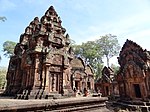 Banteay Srei
Banteay Srei Ta Keo
Ta Keo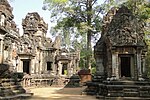 Chau Say Tevoda
Chau Say Tevoda
- Angkorian Temples in Thailand
- Phanom Rung
 Prasat Phimai
Prasat Phimai Prang Sam Yot
Prang Sam Yot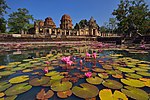 Prasat Muang Tam
Prasat Muang Tam
- Angkorian Temples in Laos
See also[]
| Wikimedia Commons has media related to Khmer Empire. |
- Post-Angkor Period
- List of kings of Cambodia – Chronological listing with reign, title and posthumous title(s), where known
 Khmer Empire travel guide from Wikivoyage
Khmer Empire travel guide from Wikivoyage
References[]
- ^ Turchin, Peter; Adams, Jonathan M.; Hall, Thomas D (December 2006). "East-West Orientation of Historical Empires". Journal of World-Systems Research. 12 (2): 223. ISSN 1076-156X. Retrieved 16 September 2016.
- ^ Rein Taagepera (September 1997). "Expansion and Contraction Patterns of Large Polities: Context for Russia". International Studies Quarterly. 41 (3): 493. doi:10.1111/0020-8833.00053. JSTOR 2600793. Retrieved 7 September 2018.
- ^ Infoplease
- ^ Reynolds, Frank. "Angkor". Encyclopædia Britannica. Encyclopædia Britannica, Inc. Retrieved 17 August 2018.
- ^ Plubins, Rodrigo. "Khmer Empire". World History Encyclopedia. Retrieved 17 August 2018.
- ^ Damian Evans; et al. (9 April 2009). "A comprehensive archaeological map of the world's largest preindustrial settlement complex at Angkor, Cambodia". Proceedings of the National Academy of Sciences. 104 (36): 14277–82. doi:10.1073/pnas.0702525104. PMC 1964867. PMID 17717084.
- ^ Thai websites web page
- ^ Jump up to: a b c d e f g h i j k l m n o p q r s t u v w x y z Coedès, George (1968). Walter F. Vella (ed.). The Indianized States of Southeast Asia. trans.Susan Brown Cowing. University of Hawaii Press. ISBN 978-0-8248-0368-1.
- ^ Jump up to: a b c d e f g h Higham, C. (2014). Early Mainland Southeast Asia. Bangkok: River Books Co., Ltd., ISBN 978-6167339443.
- ^ Higham 1989, pp. 324 ff.
- ^ Jump up to: a b c d e Higham, C. (2001). The Civilization of Angkor. London: Weidenfeld & Nicolson, ISBN 978-1842125847
- ^ Albanese, Marilia (2006). The Treasures of Angkor. Italy: White Star. p. 24. ISBN 88-544-0117-X.
- ^ Jump up to: a b c Rooney, Dawn (16 April 2011). Angkor, Cambodia's Wondrous Khmer Temples. www.bookdepository.com. Hong Kong: Odyssey Publications. ISBN 978-9622178021. Retrieved 21 January 2019.
- ^ Jump up to: a b Widyono, Benny (2008). Dancing in shadows: Sihanouk, the Khmer Rouge, and the United Nations in Cambodia. Rowman & Littlefield Publisher. ISBN 9780742555532. Retrieved 25 February 2013.
- ^ David Chandler, A History of Cambodia (Westview Press: Boulder, Colorado, 2008) p. 39.
- ^ Jacques, Claude (1972). "La carrière de Jayavarman II". BEFEO (in French). 59: 205–220. ISSN 0336-1519.
- ^ Vickery, 1998
- ^ Higham, 2001, pp. 53–59
- ^ Jacques Dumarçay; et al. (2001). Cambodian Architecture, Eight to Thirteenth Century. Brill. pp. 44–47. ISBN 90-04-11346-0.
- ^ David Chandler, A History of Cambodia, p. 42.
- ^ David G. Marr; Anthony Crothers Milner (1986). Southeast Asia in the 9th to 14th Centuries. Institute of Southeast Asian Studies, Singapore. p. 244. ISBN 9971-988-39-9. Retrieved 5 June 2014.
- ^ A History of Early Southeast Asia: Maritime Trade and Societal Development by Kenneth R. Hall p. 182
- ^ Indian History by Reddy: p. 64
- ^ Jump up to: a b c d e Kenneth R. Hall (October 1975). Khmer Commercial Development and Foreign Contacts under Sūryavarman I. Journal of the Economic and Social History of the Orient 18(3):318–336.
- ^ Jump up to: a b c R. C. Majumdar (1961), "The Overseas Expeditions of King Rājendra Cola", Artibus Asiae 24 (3/4), pp. 338–342, Artibus Asiae Publishers
- ^ Early kingdoms of the Indonesian archipelago and the Malay Peninsula by Paul Michel Munoz p. 158
- ^ Society and culture: the Asian heritage : by Juan R. Francisco, Ph.D. University of the Philippines Asian Center p. 106
- ^ Economic Development, Integration, and Morality in Asia and the Americas by Donald C. Wood p. 176
- ^ Jump up to: a b c d Maspero, G., 2002, The Champa Kingdom, Bangkok: White Lotus Co., Ltd., ISBN 9747534991
- ^ A History of India, Hermann Kulke, Dietmar Rothermund: p. 125.
- ^ Commerce and Culture in the Bay of Bengal, 1500–1800 by Om Prakash, Denys Lombard pp. 29–30
- ^ Chatterji, B. (1939). JAYAVARMAN VII (1181–1201 A.D.) (The last of the great monarchs of Cambodia). Proceedings of the Indian History Congress, 3, 380. Retrieved July 13, 2020, from www.jstor.org/stable/44252387
- ^ Jump up to: a b Cœdès 1966, p. 127
- ^ Stark, M.T. (2006). From Funan to Angkor: Collapse and regeneration in ancient Cambodia. After collapse: The regeneration of complex societies. pp. 144–167.
- ^ Welch, David (1998). "Archaeology of Northeast Thailand in Relation to the Pre-Khmer and Khmer Historical Records". International Journal of Historical Archaeology. 2 (3): 205–233. doi:10.1023/A:1027320309113. S2CID 141979595.
- ^ Jump up to: a b c Buckley, Brendan M; et al. (29 March 2010). "Climate as a contributing factor in the demise of Angkor, Cambodia" (PDF). Proceedings of the National Academy of Sciences. 107 (15): 6748–6752. Bibcode:2010PNAS..107.6748B. doi:10.1073/pnas.0910827107. PMC 2872380. PMID 20351244. Retrieved 3 June 2020.
- ^ Vickery, M. T. (1977). Cambodia after Angkor: The chronicular evidence for the fourteenth to sixteenth centuries (Vol. 2). Yale University..
- ^ Miranda Leitsinger (13 June 2004). "Scientists dig and fly over Angkor in search of answers to golden city's fall". Associated Press. Archived from the original on 10 December 2008. Retrieved 21 August 2013.
- ^ LG Gundersen. "A Reassessment of the Decline of the Khmer Empire" (PDF). Cite journal requires
|journal=(help) - ^ Jump up to: a b Masako Fukawa; Stan Fukawa (6 November 2014). "Japanese Diaspora – Cambodia". Discover Nikkei. Retrieved 18 October 2015.
- ^ "History of Cambodia, Post-Angkor Era (1431– present day)". Cambodia Travel. Retrieved 18 October 2015.
- ^ Zhou Daguan (2007). A Record of Cambodia. translated by Peter Harris. University of Washington Press. p. 70. ISBN 978-9749511244.
- ^ Jump up to: a b c d Cardiff de Alejo Garcia – Passing Notes – Smithsonian Magazine "History & Archaeology"
- ^ Welch, D.J. (1998). Archaeology of northeast Thailand in relation to the pre-Khmer and Khmer historical records. International Journal of Historical Archaeology 2(3):205–233.
- ^ Sengupta, Arputha Rani (Ed.) (2005). God and King : The Devaraja Cult in South Asian Art & Architecture. ISBN 8189233262. Retrieved 14 September 2012.CS1 maint: extra text: authors list (link)
- ^ Andrew Forbes, David Henley, Colin Hinshelwood (2012). Angkor: Eighth Wonder of the World. Cognoscenti Books. p. 108. ISBN 9781300554561.CS1 maint: uses authors parameter (link)
- ^ Zhou 2007, p. 117.
- ^ Liang 2006.
- ^ Zhou 2007, p. 57.
- ^ Keyes, 1995, pp.78–82
- ^ Tabish Khair, ed. (2006). Other Routes: 1500 Years of African and Asian Travel Writing. Indiana University Press. p. 115. ISBN 978-0253218216.
- ^ "Ancient Angkor guide book", by Michael Freeman and Claude Jacques, pp. 30–31, published in 2003.
- ^ St Julian, James (March 2014). The tale of the Khmer king and the Maharaja of Zabag. Teaching History, Volume 48 Issue 1.
- ^ Fujita Kayoko; Shiro Momoki; Anthony Reid, eds. (2013). Offshore Asia: Maritime Interactions in Eastern Asia Before Steamships, volume 18 from Nalanda-Sriwijaya series. Institute of Southeast Asian Studies. p. 97. ISBN 978-9814311779.
- ^ Munoz, Paul Michel (2006). Early Kingdoms of the Indonesian Archipelago and Malay Peninsula. Singapore: Editions Didier Miller. pp. 187–189.
- ^ India and Indonesia During the Ancien Regime: Essays by P. J. Marshall, Robert Van Niel
- ^ India and Indonesia During the Ancien Regime: Essays by P. J. Marshall, Robert Van Niel: p. 41
- ^ India: A History by John Keay p. 223
- ^ Nagarakretagama pupuh (canto) 15, these states are mentioned as Mitreka Satata, literary means "partners with common order".
Bibliography[]
- Cœdès, George (1966). The making of South East Asia. University of California Press. ISBN 0-520-05061-4.
- Freeman, Michael; (2006). Ancient Angkor. River Books. ISBN 974-8225-27-5.
- Higham, Charles (2001). The Civilization of Angkor. Phoenix. ISBN 978-1-84212-584-7.
- : Khmer Mythology, River Books, ISBN 974-8225-37-2
- Dagens, Bruno (1995) [1989]. Angkor: Heart of an Asian Empire. ‘New Horizons’ series. Translated by Sharman, Ruth. London: Thames & Hudson. ISBN 0-500-30054-2.
- Keyes, Charles F. (1995). The Golden Peninsula. University of Hawaii Press. ISBN 978-0-8248-1696-4.
- Rooney, Dawn F. (2005). Angkor: Cambodia's wondrous khmer temples (5th ed.). Odissey. ISBN 978-962-217-727-7.
- David P. Chandler: A History of Cambodia, Westview Press, ISBN 0-8133-3511-6
- Liang, Jieming (2006), Chinese Siege Warfare: Mechanical Artillery & Siege Weapons of Antiquity, Singapore, Republic of Singapore: Leong Kit Meng, ISBN 981-05-5380-3
- Zhou, Daguan (2007), The Customs of Cambodia, The Siam Society, ISBN 978-974-8359-68-7
- Henri Mouhot: Travels in Siam, Cambodia, Laos, and Annam, White Lotus Co, Ltd., ISBN 974-8434-03-6
- Vickery, Michael (1998). Society, economics, and politics in pre-Angkor Cambodia: the 7th–8th centuries. Toyo Bunko. ISBN 978-4-89656-110-4.
- Benjamin Walker, Angkor Empire: A History of the Khmer of Cambodia, Signet Press, Calcutta, 1995.
- , The Khmers of Cambodia: The story of a mysterious people
Coordinates: 13°26′N 103°50′E / 13.433°N 103.833°E
- Khmer Empire
- Former countries in Cambodian history
- Former empires in Asia
- States and territories disestablished in 1432
- 802 establishments
- 1432 disestablishments in Asia
- History of Cambodia
- Historical Hindu empires
- Indianized kingdoms
- Former countries in Southeast Asia
- 1st millennium in Cambodia
- 2nd millennium in Cambodia
- Former monarchies of Southeast Asia
